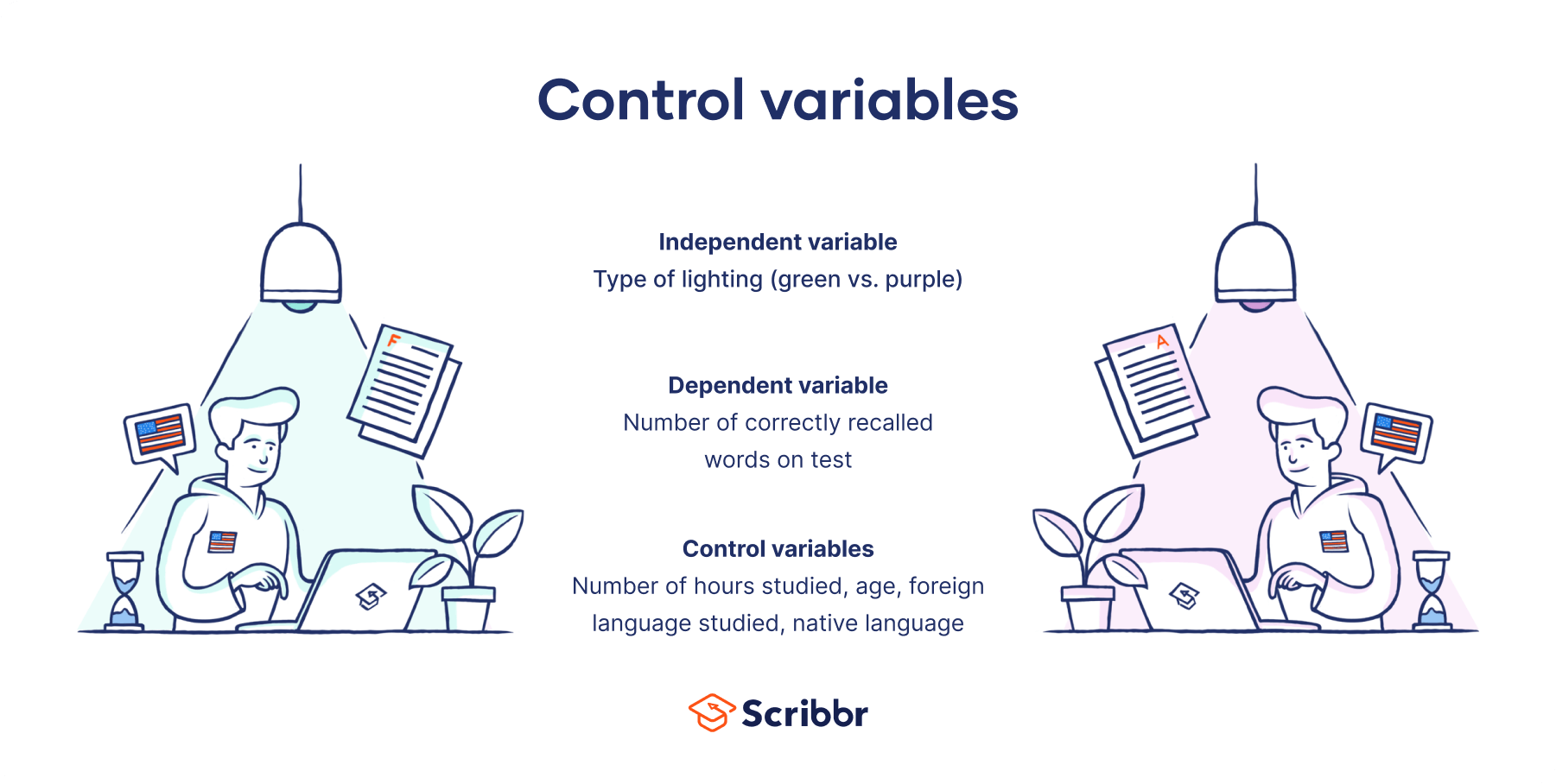What Are Control Variables? | Definition & Examples
A control variable is anything that is held constant or limited in a research study. It’s a variable that is not of interest to the study’s aims but is controlled because it could influence the outcomes.
Variables may be controlled directly by holding them constant throughout a study (e.g., by controlling the room temperature in an experiment), or they may be controlled indirectly through methods like randomisation or statistical control (e.g., to account for participant characteristics like age in statistical tests).
| Research question | Control variables |
|---|---|
| Does soil quality affect plant growth? |
|
| Does caffeine improve memory recall? |
|
| Do people with a fear of spiders perceive spider images faster than other people? |
|
Why do control variables matter?
Control variables enhance the internal validity of a study by limiting the influence of confounding and other extraneous variables. This helps you establish a correlational or causal relationship between your variables of interest.
Aside from the independent and dependent variables, all variables that can impact the results should be controlled. If you don’t control relevant variables, you may not be able to demonstrate that they didn’t influence your results. Uncontrolled variables are alternative explanations for your results.
Control variables in experiments
In an experiment, a researcher is interested in understanding the effect of an independent variable on a dependent variable. Control variables help you ensure that your results are solely caused by your experimental manipulation.
The independent variable is whether the vitamin D supplement is added to a diet, and the dependent variable is the level of alertness.
To make sure any change in alertness is caused by the vitamin D supplement and not by other factors, you control these variables that might affect alertness:
- Diet
- Timing of meals
- Caffeine intake
- Screen time
Control variables in non-experimental research
In an observational study or other types of non-experimental research, a researcher can’t manipulate the independent variable (often due to practical or ethical considerations). Instead, control variables are measured and taken into account to infer relationships between the main variables of interest.
To account for other factors that are likely to influence the results, you also measure these control variables:
- Age
- Marital status
- Health
How do you control a variable?
There are several ways to control extraneous variables in experimental designs, and some of these can also be used in observational or quasi-experimental designs.
Random assignment
In experimental studies with multiple groups, participants should be randomly assigned to the different conditions. Random assignment helps you balance the characteristics of groups so that there are no systematic differences between them.
This method of assignment controls participant variables that might otherwise differ between groups and skew your results.
It’s possible that the participants who found the study through Facebook have more screen time during the day, and this might influence how alert they are in your study.
To make sure that participant characteristics have no effect on the study, participants are randomly assigned to one of two groups: a control group or an experimental group.
Standardised procedures
It’s important to use the same procedures across all groups in an experiment. The groups should only differ in the independent variable manipulation so that you can isolate its effect on the dependent variable (the results).
To control variables, you can hold them constant at a fixed level using a protocol that you design and use for all participant sessions. For example, the instructions and time spent on an experimental task should be the same for all participants in a laboratory setting.
- To control for diet, fresh and frozen meals are delivered to participants three times a day.
- To control meal timings, participants are instructed to eat breakfast at 9:30, lunch at 13:00, and dinner at 18:30.
- To control caffeine intake, participants are asked to consume a maximum of one cup of coffee a day.
For the experimental manipulation, the control group is given a placebo, while the experimental group receives a vitamin D supplement. The condition they are in is unknown to participants, and they are all asked to take these pills daily after lunch.
Statistical controls
You can measure and control for extraneous variables statistically to remove their effects on other variables.
“Controlling for a variable” means modelling control variable data along with independent and dependent variable data in regression analyses and ANCOVAs. That way, you can isolate the control variable’s effects from the relationship between the variables of interest.
In a multiple linear regression analysis, you add all control variables along with the independent variable as predictors. The results tell you how much happiness can be predicted by income, while holding age, marital status, and health fixed.
Control variable vs control group
A control variable isn’t the same as a control group. Control variables are held constant or measured throughout a study for both control and experimental groups, while an independent variable varies between control and experimental groups.
A control group doesn’t undergo the experimental treatment of interest, and its outcomes are compared with those of the experimental group. A control group usually has either no treatment, a standard treatment that’s already widely used, or a placebo (a fake treatment).
Aside from the experimental treatment, everything else in an experimental procedure should be the same between an experimental and control group.
Frequently asked questions about control variables
Cite this Scribbr article
If you want to cite this source, you can copy and paste the citation or click the ‘Cite this Scribbr article’ button to automatically add the citation to our free Reference Generator.
Bhandari, P. (2023, June 16). What Are Control Variables? | Definition & Examples. Scribbr. Retrieved 15 December 2025, from https://www.scribbr.co.uk/research-methods/control-variables/

